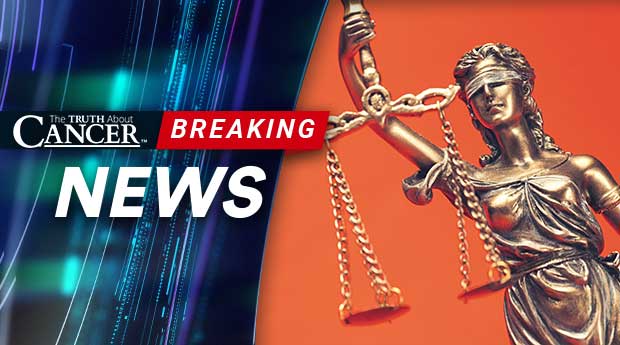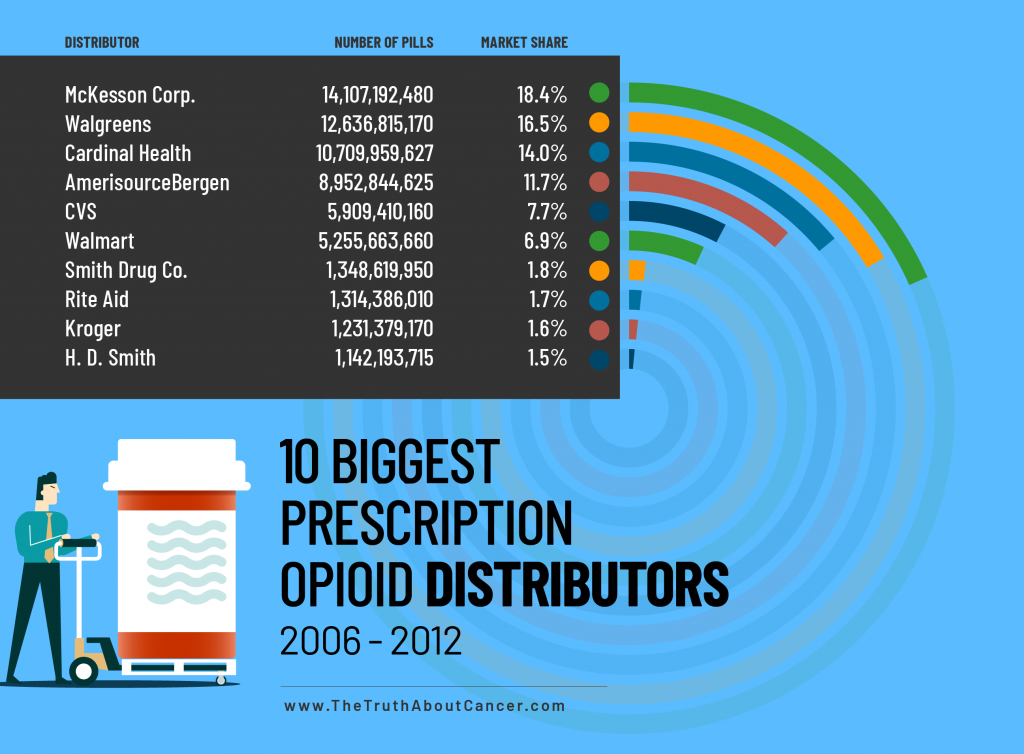An Oklahoma judge ruled yesterday that Johnson & Johnson was directly responsible for fueling the state’s opioid crisis. Attorneys for the state called Johnson & Johnson the “kingpin” of the opioid epidemic. The landmark ruling is the first to hold a manufacturer responsible for the opioid crisis and will likely serve as a litmus test for over 2,000 similar cases across the nation.
Johnson & Johnson Found Guilty
In the afternoon decision, Judge Thad Balkman ordered Johnson & Johnson to pay over $572 million to help the state combat addiction and provide treatment for those already affected. Balkman was incredibly clear in his verdict, saying that Johnson & Johnson had used “false, misleading, and dangerous marketing campaigns” that “caused exponentially increasing rates of addiction, overdose deaths,” and harm to infants.
The case, accusing manufacturers of violating public nuisance laws by fueling the opioid crisis, originally included Purdue Pharma (the creators of OxyContin) and Teva Pharmaceuticals (a major supplier of generic opioids). Both chose to settle with the state for $270 million and $85 million, respectively. Johnson & Johnson chose to fight the accusations in court.
Known for Band-Aids and baby shampoo, Johnson & Johnson generates about 90% of their profit from prescription drugs and medical equipment. Over the course of the trial, which was televised and streamed live online, the company was exposed as perhaps the worst offender in deliberately misleading doctors and patients about opioid safety as the death toll continued to climb.
While Johnson & Johnson may not be one of the largest distributors of opioid drugs, it was revealed that Johnson & Johnson’s subsidiaries manufactured about 60% of the raw ingredients used to make opioid painkillers. They aggressively marketed opioids to doctors and patients as safe, minimizing the risks of addiction and encouraging expanded use.
The Cost of Lies
When these drugs were first introduced, they were used sparingly, for terminal cancer, surgery, or end-of-life patients with extreme pain. Thanks to an aggressive marketing campaign, opioids are prescribed much more liberally. From 2015 to 2018, over 18 million opioid prescriptions were written for a state with a population of less than 4 million. This equates to more than 1.15 prescriptions for every man, woman, and child in the state each year.
Over the past 20 years, more than 6,000 Oklahomans died from opioid overdoses. In 2017, the number of opioid prescriptions dispensed by pharmacies reached 479 every hour.
State attorney Brad Beckworth summarized the issue in his opening statements with this simple phrase:
If you oversupply, people will die.”
He provided detailed statistics showing a direct correlation between opioid prescriptions and overdose deaths, accusing Johnson & Johnson of knowingly placing patients in harm’s way in order to generate profits. “We’ve shown that J & J was at the root cause of this opioid crisis,” Beckworth said after the ruling.
It made billions of dollars from it over a 20-year period. They’ve always denied responsibility and yet at the same time they say they want to make a difference in solving this problem. So do the right thing: Come in here, pay the judgment.”
Witnesses in the trial included the family members of those who perished due to opioid overdose, including Craig Box. Box’s son Austin was a star football player at the University of Oklahoma with a bright future. Austin was plagued with injuries during his football career, some of them requiring surgery. Doctors prescribed opioids to help him manage the pain. In 2011, he was found dead at a friend’s apartment, another victim of opioid overdose.
Through tears, Austin’s father described the devastation of losing his son.
I can’t explain what happens to you as a parent when a child dies,” he testified. “We never suspected anything. In 2011, this crisis that everybody on both sides of the aisle calls it, nobody knew about it. [Parents] had no idea and had no clue about the prevalence of these drugs and the dangers of these drugs,” he added.
The state’s final witness may have been the most heart-wrenching. Terri White, the Oklahoma mental health commissioner, testified that Johnson & Johnson were wrong in denying responsibility. She says their claims of innocence are “absolutely incorrect” and “one of the most difficult things to swallow.”
To hear them say that they bear zero responsibility, it’s painful,” she said. “They unleashed a series of bombs on the United States of America, and those bombs hit squarely – squarely – on the middle of our country in Oklahoma. When you prey on a state that is vulnerable to addiction, that offends my decency.”
During a video montage of Austin Box, White burst into tears once again. “Austin is one of the reasons I fight every single day,” she said.
Dr. Andrew Kolodny, the co-director of the Opioid Policy Research Collaborative at Brandeis University, testified that Johnson & Johnson was perhaps the worst offender when it comes to the opioid crisis, saying that their role may be even worse than OxyContin maker Perdue Pharma.
He compared the importance of this trial to that of The Master Settlement Agreement against Big Tobacco in 1998. It was the first time that the tobacco industry was truly exposed for hiding the dangers of smoking and profiting at the expense of public health. The settlement required manufacturers to pay a minimum of $206 billion over the first 25 years, and permanently changed the way Americans view smoking.
The Systemic Failure of the Medical Industry
The trial in Oklahoma was a victory against the greed of big pharma. Although the settlement was much less than the $17 billion the state was seeking, it sets a precedent that will undoubtedly be used against opioid manufacturers who face over 2,000 lawsuits throughout the country. This October, a federal judge in Ohio is set to hear a combined lawsuit brought by almost 2,000 cities, counties, and native American tribes.
But Oklahoma is not alone in this crisis, despite seeing thousands of deaths and countless more cases of addiction across the state. In an exposé by the Washington Post, a DEA database was used to determine just how hard counties were hit by the blatant negligence, apathy, and greed of the pharmaceutical industry.
The data shows a systemic failure by manufacturers, pharmacies, doctors, and distributors. From 2006 to 2012, the number of oxycodone and hydrocodone pills shipped by the industry skyrocketed from 8.4 billion to 12.6 billion – a 50% increase in just 6 years. The period saw the distribution of more than 76 billion pills, almost 40 pills for every American citizen every year.
With more than 200,000 overdose deaths since 1996, Americans are now more likely to die from an opioid overdose than a car accident. Court documents have repeatedly shown that manufacturers aggressively marketed to doctors, pushing them to prescribe more and more drugs. Pain clinics, often referred to as “pill mills,” have funneled billions of pills into the most vulnerable communities.
States with rural populations were clearly targeted, and opioid deaths in those regions reflect the flood of drugs distributed. For West Virginia, there were 66.5 pills distributed for every single resident each year. They were followed by Kentucky with 63.3, South Carolina with 58, Tennessee with 57.7, and Nevada with 54.7. West Virginia had the highest number of opioid deaths in the nation during this period.
Certain counties were specifically targeted, with manufacturers, distributors, doctors, and pharmacies pumping ungodly amounts of dangerous drugs into the population. From 2006 to 2012, Norton, VA distributed 306 pills per person per year. Martinsville, VA received 242 per person. In West Virginia, Mingo County distributed 203 opioid pills per person each year.
And just a few distributors were responsible for pushing the vast majority of these drugs. Just 6 companies distributed 75% of the opioid pills from 2006 to 2012; McKesson Corp., Walgreens, Cardinal Health, AmerisourceBergen, CVS, and Walmart. McKesson distributed 14.1 billion pills. Walgreens and Cardinal Health distributed 12.6 billion and 10.7 billion pills, respectively.
The time has come for those responsible to pay the price for the negligent deaths of hundreds of thousands of Americans. And pharmaceutical companies are not alone. Earlier this month, California’s attorney general charged a doctor with 4 murder charges and felony elderly abuse for overprescribing opioids that led to 4 patients dying.
In May, a jury found the top executives of pharmaceutical company Insys guilty of racketeering. All 5 executives, including former billionaire and company founder John Kapoor, are now convicted felons who will serve time in federal prison.
Their crimes? Bribing doctors to prescribe their fentanyl painkiller Subsys and lying to insurers about patient need for the drug.
These doctors were being lobbied, bribed, and coerced by some of the best in the business. Insys regularly hired adult entertainers and even sex workers as sales executives, and court testimony revealed that doctors would often be invited to “business lunches” at unsavory adult venues. Executives even created a promotional rap video encouraging their sales team to keep pushing their drug.
In April, 60 doctors were charged with crimes that included illegal prescriptions, drug trafficking, prostitution, and insurance fraud. Some doctors even performed unnecessary tooth extractions so they could prescribe the drug. The doctors were from 5 different states in Appalachia and wrote more than 350,000 illegal prescriptions.
The Deadly Toll of Secrecy
The DEA data obtained by the Post was not easy to obtain. Manufacturers, the DEA, and the Justice Department fought fiercely to keep the database secret but were overruled in court. But doctors, manufacturers, and pharmacies are not the only ones to blame. Judges, through secrecy, have also played a part in the opioid epidemic.
In previous cases against Purdue Pharma, more than a dozen judges evaluated thousands of pages of internal documents that clearly demonstrated Purdue’s liability. But each of these cases was settled before trial, and the documents sealed from regulators, doctors, and patients. Federal Judge Dan Polster has overseen nearly 2,000 similar cases. He has aggressively maintained the secrecy of court documents that expose the blatant disregard for human life displayed by defendants.
In many cases, the secrecy may have been illegal. Court records are presumed to be public and are only allowed to be sealed for valid privacy concerns, like patient records or trade secrets. In most states and federal appellate courts, judges are required to weigh any request for secrecy against the public benefit of making them available. These judges are also required to explain in court documents why they chose to seal records, but there are no repercussions if they fail to do so.
Without these documents, it has become nearly impossible for the public to understand the extent to which companies and doctors have lied or manipulated doctors and patients in the interest of profits. 35 boxes of call notes that were entered into evidence reveal that Johnson & Johnson sales representatives called doctors hundreds of thousands of times, often using bogus speaker programs to provide financial incentives for those with the highest prescription rates.
In July, emails were leaked between Victor Borelli, a national account manager for opioid manufacturer Mallinckrodt, and Steve Cochrane, the vice president of sales for KeySource Medical, a major distributor. The conversation, from the center of the opioid crisis in 2008, is extremely disturbing.
Borelli asked Cochrane to check his inventory:
VB: “If you are low, order more. If you are okay, order a little more, Capesce? …destroy this email. . .Is that really possible? Oh Well. . .”
SC: “Keep ’em comin’! Flyin’ out of there. It’s like people are addicted to these things or something. Oh, wait, people are. . .”
VB: “Just like Doritos keep eating. We’ll make more.”
In 2010, Borelli received a bonus in excess of $110,000. In a deposition, lawyers asked if the bonus was connected to the number of narcotics he was selling. “Yes,” Borelli answered.
The verdict against Johnson & Johnson is a major step forward. For too long, mega-corporations have put the public at risk to increase profits. Those who speak up against Big Pharma are often shouted down as conspiracy theorists. But the documents revealed in the Johnson & Johnson case have made one thing clear: the conspiracy is real.
Companies are lying about the safety of their drugs. Sales representatives are crossing legal and ethical boundaries to push more and more product, despite the overwhelming harm to patients. Doctors and distributors are recklessly prescribing and distributing billions of opioids as the death toll continues to climb.
The Dawn of Justice
And opioids aren’t the only problem. These companies are paying to have other drugs rushed through FDA approval. Safety studies are being altered so that companies can make profits. Agricultural companies are poisoning our food and water to make an extra buck. We are being lied to.
While there are many doctors who choose their careers in order to help people, too many of them are being lied to or bribed. The curriculum is created by the industry, with a focus on drugs and surgery that generate profit. The FDA, CDC, EPA, FCC, and others are bought and paid for by the very industries they’re meant to regulate.
The system is broken, and we need to stop believing the lies. From vaccines to painkillers, chemo to surgical mesh, the truth keeps coming to light: PATIENT SAFETY IS NOT IMPORTANT. But the age of justice may be upon us. Johnson & Johnson is just the first in a long string of opioid lawsuits. Bayer’s agricultural chemicals are being exposed for the cancer-causing toxins that they are. Dentists are now faced with evidence that highlights the dangers of fluoride. Major tech industries have been exposed for lying about cell phone radiation.
The only way these companies and industries can continue to profit at the expense of the people is if we stay blind. The push to censor our information and take away our freedoms has reached a fevered pitch, and for good reason – we’re finally starting to wake up.
We have been lied to for centuries so that a few people can become rich. Meanwhile, we are literally dying. The time to act is now. Question authority. If you’re tired of being lied to, speak up. Demand transparency. The settlement against Johnson & Johnson is just a drop in the bucket – about a dollar for every life lost to opioid addiction. But the tide of justice is shifting. The truth is finally coming into the light.
Evildoers beware! Your reign of lies and deceit is at an end.




















For many years since I was a tiny little baby, I used Johnson and Johnson baby shampoo, Johnson and Johnson baby powder, and its Band-Aids, but nobody ever warned us about the opoids and toxins in there.
Hello this is Mayke from the Netherlands,
Thank you so much for your work and efforts for our health and for revealing the thruth. America is a very very sick country regarding making profits over health.
I hope Monsanto also will be held responsible for destroying the whole world and making the planet, nature, animals and humans sick. They have to be sent to prison.